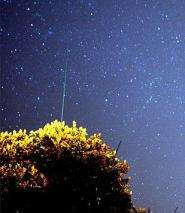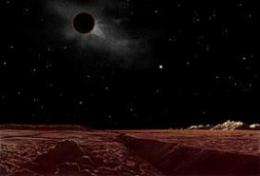Two light shows for skywatchers coming this month

Two great light shows should be visible to Arizonans this month: the annual Geminids meteor shower and a total lunar eclipse.
The next couple of weeks will offer two premier viewing opportunities for sky watchers in Arizona and the Southwest.
Year in and year out, the two best meteor showers to watch are the Perseids in August and the Geminids, which are coming up in the early morning hours of Dec. 14.
"If the sky is clear where you live," said Carl Hergenrother, a senior researcher at the University of Arizona Lunar and Planetary Laboratory, "this Tuesday morning will provide one of the few nights of the year when it's almost guaranteed that you will be able to observe a meteor after about 10-20 minutes of observing."
Observers in the Americas could be in for a good show. In a dark sky, the Geminids have been known to produce rates of up to 120 meteors per hour at their peak. Unlike most meteor showers that can only be observed in the early hours of the morning, the Geminids' radiant – the point in the sky from which meteors appear to originate – rises as early as 7 p.m. and a good number of meteors can be seen by 10 p.m.

The radiant is nearly overhead at 2 a.m. and well-placed for the rest of the night. This year the first quarter moon (located close to a brilliant Jupiter) will hinder Geminids watching until it sets at about 12:45 a.m.
Hergenrother said a few early Geminids have been seen during the past week, but the peak night, Dec. 13-14, should be the best. Starting in the evening look to the northeastern sky. The Geminids appear to radiate from the constellation of Gemini, specifically near the bright star Castor, the northern star in the Castor-Pollux pair. By the middle of the night, the radiant will be nearly overhead and meteors will be raining down on all sides.
Rather than looking directly at the radiant, it is easier to see meteors by looking 30 degrees or more away from the radiant. For reference, 10 degrees is about the width of a hand held at arm's length. The key is to look up and you should see quite a few Geminids.
For the best viewing experience, Hergenrother recommends finding the darkest skies with the fewest obstructions. That means getting away from city lights, buildings and trees. In places with pitch black skies, it's possible to see as many as 120 meteors an hour once your eyes have adjusted. The rate will be a bit lower in rural areas near small towns. Tucsonans could see between 20 and 60 per hour. In major urban areas it could be as few as two to 10 per hour. Remember to bundle up as well.
The Winter Solstice will offer another astronomical treat – a total lunar eclipse on the night of Dec. 20-21. From Tucson, the darkest part of the eclipse – the umbra – starts at 11:32 p.m. and ends at 3:02 a.m. Totality – when Earth's shadow completely covers the moon – lasts from 12:40 a.m. to 1:54 a.m. And because it is the winter solstice, the moon will be riding nearly overhead during the eclipse.
For those willing to brave the frigid summit of the Santa Catalina Mountains, the UA's Mount Lemmon SkyCenter has information online about their public viewing programs during the Geminid meteor shower and the lunar eclipse.
More information: More details on the Geminid meteor shower online are available here: transientsky.wordpress.com/201 … f-the-2010-geminids/
Provided by University of Arizona





















